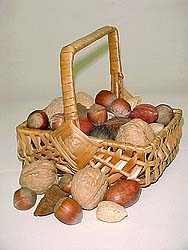




Some 50 pitted stones with at least one depression were found at the Israel site. The depression in the stones appeared to have been formed when the stones were used to crack open large quantities of hard nuts. These stone tools, called "nutting stones", are similar to those found in the United States and Europe which archeologists date back 4,000 to 8,000 years.
These early Native Americans would place a nut in the depression of the stone, then hit it with another stone called the "hammer stone" The shelled nuts were eaten whole, and also were ground with mortar and pestle to make flour, or a nut butter. Nuts used were beech nuts, chestnuts, hickory nuts, and walnuts. After removing the nutmeats, the shells were used to fuel their fires. Many times the nutmeats were cooked, and when the broth cooled, the congealed fat would be taken off and saved for later cooking.
All of this evidence shows that nuts have been a staple in the human diet for since the beginnings of history.
The oldest walnut remains were discovered in Iraq, and they are believed to be from 50,000 B.C. The Greeks and Romans were fond of the walnut, and they were considered food for Gods by early Romans. They were also used for oil and sometimes were powdered to thicken foods much as cornstarch is used today. Walnuts were used as a common trade item by English ships throughout the Mediterranean. That is why it is called the "English Walnut". Walnuts were brought to California by Franciscan Fathers from Spain in the 18th century. Today California produces much of the world's supply.
Remains of pecans were found in archeological excavations in Texas with human artifacts which date back to 6100 B.C. The pecan, which is native only to North America, was found in or near river beds and was a staple in the diets of both the natives and the early settlers.
We all connect the macadamia nut to Hawaii but it originated in the rain forests of Queensland, Australia. It was brought to Hawaii in the late 19th century where much of the world's supply is grown today.
Historians say that almonds, mentioned in the Old Testament of the Bible, were among the earliest cultivated foods. The almond has been found in excavation sites in both Cyprus and Greece. The famous Arabian marzipan, a sweet paste candy made from ground almonds, was brought back by the Crusaders returning from the Holy Lands in the 11th and 13th centuries and still remains popular today.
The hazelnut, or filbert, has been around a long time. Some think the hazelnut and filbert are the same while others think they are cousins. This nut has also been known as the Cobb nut or Spanish Nut. A manuscript found in China from the year 2838 B.C. places the hazelnut among the five sacred nourishments God bestowed on human beings. The name filbert comes from St. Philibert, a 7th century Frankish abbot, and the nut usually ripens on St. Philibert's Day, August 29. The word hazel comes from an old English word for hood, or bonnet. The hazelnut was introduced to America by a shipment of seeds in 1629, and it is grown mostly in Oregon and Washington, which produce about 3% of the world's supply.
The cashew nut is native to Brazil but has been widely cultivated in Indian and Africa since the 16th century. It was introduced to the Philippines by the Spanish traders. Cashews always come to us shelled because between the outer and inner shells there is a caustic oil. The outer shell and oil are burned or roasted off after which the nut is boiled or roasted again to remove the inner shell.
The Brazil nut is native to South America growing well in the Amazon basin. Brazil nuts are actually large seeds with 15 to 30 arranged in a pod much like the sections of an orange. This pod weighs 4 to 6 pounds and hits the ground with such force that a man could be killed if hit. Natives gather the pods when they fall and open them with machetes to remove the seeds. Animals also take the pods and bury them for food, and inadvertently help to replenish the natural habitat. The first reference to the Brazil nut dates to 1569 when a Spanish colonial officer collected thousands of them to feed his troops. Brazil nuts were first introduced to the Europeans by Dutch traders in the late 17th century.
The peanut is not really a nut but a goober and a member of the pea family. They originated in South America where the Indians have used them over 2000 years. Spanish and Portuguese slave traders introduced them to Africa and Europe, and the slaves in turn brought them to the US. At first the peanut was regarded as a food for poor people, but by the turn of the 20th century there was a great demand for peanut oil, roasted and salted peanuts as well as the new peanut butter.
Be sure to visit our Recipe section for great recipes by the Nutcracker Lady. We add new ones regularly and announce on our Facebook page when they are added.
We also welcome recipes donated from museum and website visitors. The only requirement is your recipe must include nuts and you must have legal rights to share it.

Here is some great nutritional information about the nut.
Monday - Saturday 11-5pm
Sunday - 11-4:30pm
We suggest visitors arrive at least 30 minutes before closing.
"To foster and encourage the interest of the general public of the importance of nuts in the diets of humans throughout history and in the evolution of the nutcracker. No other tool or collectible has shown such a wide diversity of material and design as the implements used to crack the hard shell of a nut".